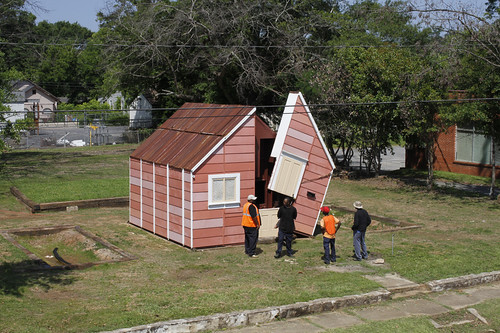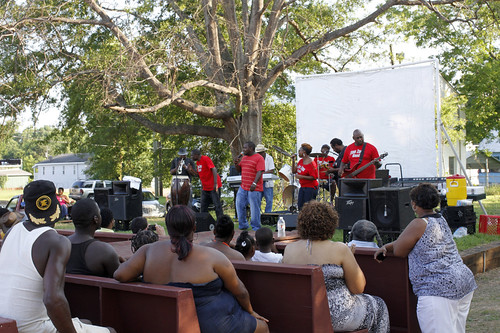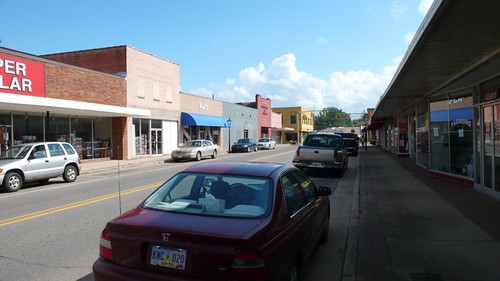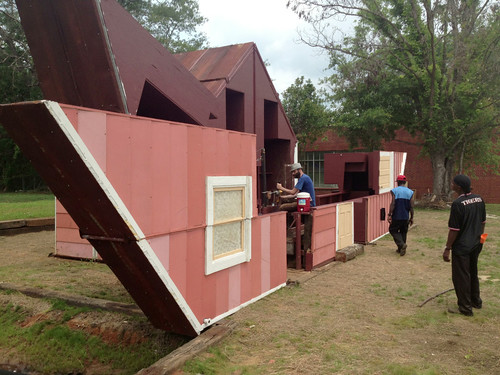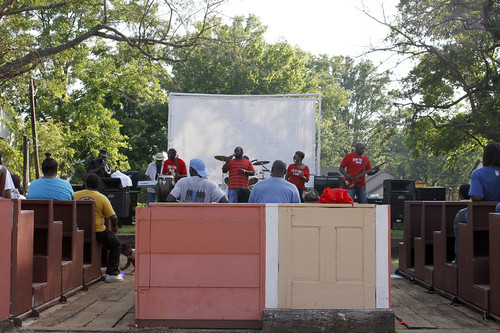Amazing collaboration transforms decay into a new heart for small town

Posted October 17, 2013 at 1:30PM
This abandoned, blighted property . . .
Has been recycled into this modest cottage, which amazingly opens . . .
On call, to become a vital community performance venue.
The modest rural town of York, Alabama is now home to one of the most inspiring new public spaces I have seen anywhere. Called Open House, the remarkable outdoor “theater in the shape of a house” was conceived by artist Matthew Mazzotta and crafted by townspeople, with the assistance of York's Coleman Center for the Arts. I was introduced to Open House by a short article by Jodi Weinberger on the Rooflines blog. Watch the first video below to see the house open in a very literal way, and prepare to be impressed.
To put the project in perspective, York is a community of just under 3000 people, 78 percent African American, close to the Mississippi border. The town has fallen on hard times: The median income for a household in York is only $19,153, well less than half that of the nation as a whole. Over a third of York’s families live below the poverty line, “including 50.6% of those under age 18,” according to the town’s Wikipedia entry. The City of York is deeply in debt due to unpaid payroll taxes and a high-interest loan taken out in 2012 in a desperate attempt to right the fiscal ship.
York’s main drag, called Broad Street, is now more an evocation of a small downtown than a real one, many of its once-thriving shops abandoned and boarded up. Many of the town’s residences are also abandoned and blighted.
Indeed, such was the case with the property that became Open House (see photo at top of post). Its amazing transformation began in a makeshift “living room.” From the project’s web site:
“Mazzotta invited area residents to join him for a creative discussion about public space. Sitting in an outdoor living room nestled inside of orange cones on the middle of Avenue A, area residents brought items from their homes to lend to the outdoor living room. The conversation that followed highlighted participants’ love for York but also their frustration with the community’s loss of public space, the spread of blight and the lack of racially integrated and secular social spaces. The conversation served as an impetus for ‘Open House’ which has transformed a blighted property into a public outdoor theater in downtown York.
“Mazzotta’s sculpture is a theater in the shape of a house. An unlikely object, in its closed state it is a neatly cubed house made with the faded pink siding that covered its blighted predecessor. An iconic, ‘housey’ looking house, it projects the very idea of a house itself. Shelter, charm, warmth, safety. When transformed it unfolds in ten pieces on specially commissioned industrial hinges into seats for nearly 100 people. The seats, graduated for height, face a raised earthen stage. It is a public space made from the remnants of a privately owned blighted property, like those that still litter the landscape across rural Alabama and so many other parts of America, urban and rural alike.”
I find the web site particularly eloquent in its discussion of the house as metaphor, and I encourage interested readers to take a look.
The “house,” made in part from materials recycled from the former property, was designed to require cooperation among at least four community workers to be opened into its reincarnation as a performance space. After each use, it is simply folded back into form. Open House now stands as a powerful reminder that financial poverty shouldn't be taken to mean cultural or social poverty.
In the six years that I have been researching articles for this blog, I’ve run across some wonderful collaborative arts projects that have transformed their communities while engaging residents and visitors in provocative ways. Houston’s Project Row Houses may be my favorite; Candy Chang’s “Before I Die” series that started in New Orleans also springs immediately to mind, as does Detroit’s Heidelberg Project. These low-key, highly inspirational works are amazing and have provided fodder for some of my favorite writing. Add Open House to that list of favorites.
The first video below is only a minute long, showing how the transformation and putting-back-together works. It is remarkable in itself, but the second, which tells the more complete and inspiring story, is even better:
Related posts:
- Enlivening dead city spaces with street art (September 13, 2013)
- New round of arts grants help revitalize and animate city neighborhoods (May 20, 2013)
- How a tough neighborhood is building a stronger future with vivid public art (November 16, 2012)
- Community art or community development? Yes and yes, in Houston's inspiring Project Row Houses (September 20, 2012)
- A powerful statement in the form of urban folk art: Detroit's amazing Heidelberg Project (August 2, 2011)
- The role of the arts in thriving communities (July 28, 2011)
- Strengthening community through interactive street art (NOLA resilience part 2) (May 12, 2011)
Move your cursor over the images for credit information.
Kaid’s forthcoming book, People Habitat: 25 Ways to Think About Greener, Healthier Cities, will be released in January.

